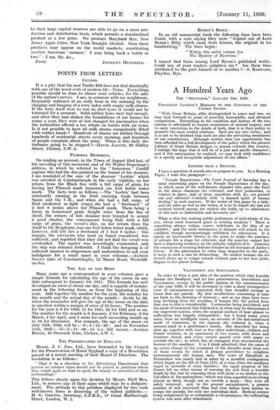POINTS FROM LETTERS
CHURNS.
It is a pity that the new Traffic Bill does not deal drastically with one of the worst evils of modern life—Noise. Everything possible should be done to silence road vehicles, for the sake of the nation's nerves. I am, in common with my neighbours, frequently wakened at an early hour in the morning by the clanging and banging of a lorry laden with empty milk churns. If the lorry itself were to run on steel tyres it would not be tolerated for a moment. Solid rubber tyres were bad enough, and after they had shaken the foundations of our houses for many a year, they were at last changed for pneumatics when the authorities offered a tax rebate on lorries with air tyres. Is it not possible to have all milk churns compulsorily fitted with rubber bands ? Hundreds of churns are rattled through hundreds of residential streets every morning, and hundreds of people complain about the noise. When is this daily dis- tUrbance going to be stopped ?—DAVID JAGGER, 30 Oakley Street, Chelsea, S.W. 8.
PLIMSOLL MEMORIAL.
On reading an account, in the Times of August 23rd last, of the unveiling of this memorial, and of Sir Walter Runciman's address, in which he referred to the " humorous " Cardiff captain who had the disc painted on the funnel of his steamer, I am reminded of the case of the steamer Lestris ' which was arrested at Constantinople in the early 'eighties, on her return from the Black Sea with a full cargo of grain, for having her Plimsoll mark immersed one foot below water mark. The facts were as follows :—The Lestris' had been constantly running in the fruit carrying trade between Spain and the U.K. and when she had a full cargo of fruit (reckoned as light cargo) she had a " freeboard ' of 2 feet 8 inches above her Plimsoll mark. There being a boom in homeward grain freight rates from the Sea of Azoff, the owners of this steamer were tempted to accept a good charter, the consequence being that with a full cargo of grain, the vessel's disc, on her return from the Azoff to the Bosphorus, was one foot below water mark, which, however, still left her a freeboard of 1 foot 8 inches • this margin, the surveyors who went on board considered, was sufficient, and reported that they did not find the vessel was overloaded. The master was accordingly exonerated, and the ship was released forthwith. I think the foregoing is of sufficient interest to shipowners and underwriters to ask your indulgence for a small space in your columns.—ALFRED SILLEY (late of Constantinople), 12 Manor Road, Westcliff- on-Sea.
TEE AGE OF THE MOON
Many years ago a correspondent in your columns gave a simple formula for calculating the age of the moon on any date subsequent to January 1st, 1911. This formula has now developed an error of about one day, and is capable of restate- ment in the following form, as from the beginning of this year. Add together the number for the year, the number for the month and the actual day of the month : divide by 30, when the remainder will give the age of the moon on the date in question within a margin of error of 24 hours. The number for the year is 0 for 1930, 11 for 1931, 22 for 1932 and so on. The number for the month is 0 January, 2 for February, 0 for March, 2 for April, and 1 more for each succeeding month up to 10 for December. For example, the age of the moon on July 15th, 1930, will be :-0+5+15=20 ; and on November 11th, 1935 :-55 + 9 +11--60 =15 (i.e. full moon).—ALFRED BOOTH, 10 Ormonde Gate, Chelsea, S.W. 1.
THE PRESERVATION OF ENGLAND
Messrs. J. C. Eno, Ltd., have forwarded to the Council for the Preservation of Rural England a copy of a Resolution passed at a recent meeting of their Board of Directors. The resolution is as follows :
" That it be a direction to the Advertising Department that posters or outdoor signs should not be placed in positions where they would spoil, or tend to spoil, the beauty or amenities of their surroundings."
This follows closely upon the decision by Messrs. Shell Mex, Ltd., to remove any of their signs which may be a disfigure- ment. The attitude to this problem displayed by two such well-known firms is deserving of the widest publicity.— H. G. GIUFFIN, Secretary, C.P.R.E., 17 Great Marlborough Street, London, W. 1.
BYRON'S BIBLE.
In ,an old manuscript book the following lines have been found, with a note saying they were " Copied out of Lord Byron's Bible which came from Greece, the original in his handwriting." The lines begin: " Within this awful volume lies The Mystery of Mysteries."
I cannot find them among Lord Byron's published works. Could any of your readers enlighten me ? Are these lines attributed to the poet himself or to another ?—S. BARNARD, Playden, Rye.






































 Previous page
Previous page